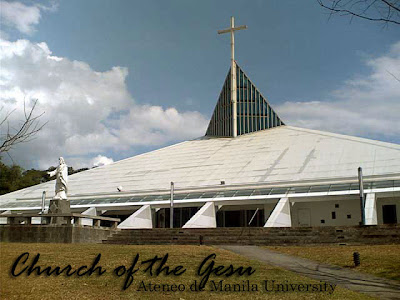 Yesterday, I attended a Mass for Ateneo jubilarian classes at the Church of the Gesu in Ateneo. My high school batch is celebrating its tenth anniversary this year. The Mass really brought back memories since all of a sudden, I was an impromptu lector and altar server. Hehe!
Yesterday, I attended a Mass for Ateneo jubilarian classes at the Church of the Gesu in Ateneo. My high school batch is celebrating its tenth anniversary this year. The Mass really brought back memories since all of a sudden, I was an impromptu lector and altar server. Hehe! The Church of the Gesu was built several years after I left the Ateneo and transferred to neighboring UP. It was a low hill during my twelve years stay at the Loyola Heights campus. Although we already knew that the University Church, one that would replace the grand San Ignacio Church in Intramuros as the landmark church and religious center of the Ateneo de Manila, would be built on that hill. According to the Ateneo website, it was in 1949 that "Fr. William Masterson, S.J. dreamed of a chapel on the highest point of Ateneo’s new campus in Loyola Heights, which was to be the icon of everything the Ateneo stands for as a Catholic, Filipino and Jesuit institution." More than 50 years later, that dream became a reality and the finished product is nothing but impressive!Designed by Jose Pedro Recio and Carmelo Casas, "the Church’s striking triangular architecture symbolizes 3 things: the Holy Trinity, the outstretched arms of the Sacred Heart, and the Filipino spirit as embodied in the nipa hut roof it represents." Years from now, it's brilliantly-designed edifices like the Gesu which will fall in the category of heritage, and not those haughty, nouveau riche designs we see in many of our churches today.
The Church of the Gesu was built several years after I left the Ateneo and transferred to neighboring UP. It was a low hill during my twelve years stay at the Loyola Heights campus. Although we already knew that the University Church, one that would replace the grand San Ignacio Church in Intramuros as the landmark church and religious center of the Ateneo de Manila, would be built on that hill. According to the Ateneo website, it was in 1949 that "Fr. William Masterson, S.J. dreamed of a chapel on the highest point of Ateneo’s new campus in Loyola Heights, which was to be the icon of everything the Ateneo stands for as a Catholic, Filipino and Jesuit institution." More than 50 years later, that dream became a reality and the finished product is nothing but impressive!Designed by Jose Pedro Recio and Carmelo Casas, "the Church’s striking triangular architecture symbolizes 3 things: the Holy Trinity, the outstretched arms of the Sacred Heart, and the Filipino spirit as embodied in the nipa hut roof it represents." Years from now, it's brilliantly-designed edifices like the Gesu which will fall in the category of heritage, and not those haughty, nouveau riche designs we see in many of our churches today.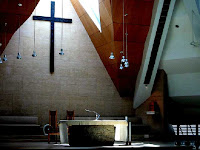 Archt. Paolo Alcazaren gives us more information on the impressive design of the Gesu in his Philippine Star column: "The church is a modernist take on a long line of Jesuit churches that have their origins in the original Gesu in Rome. The Ateneo has had several of these churches starting with the one destroyed in Intramuros. The campus in Loyola, to which the school moved after the Second World War, was also a modern remake of a formerly urban campus with wide, open and green spaces (undefiled by telephone and power cables, which the original planners – thank God – buried underneath).
Archt. Paolo Alcazaren gives us more information on the impressive design of the Gesu in his Philippine Star column: "The church is a modernist take on a long line of Jesuit churches that have their origins in the original Gesu in Rome. The Ateneo has had several of these churches starting with the one destroyed in Intramuros. The campus in Loyola, to which the school moved after the Second World War, was also a modern remake of a formerly urban campus with wide, open and green spaces (undefiled by telephone and power cables, which the original planners – thank God – buried underneath).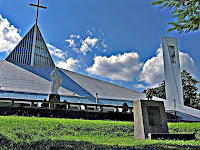 "The Ateneo chose the firm of Recio+Casas to design the new Gesu. Bong Recio, the principal in charge, is an alumnus. He took pains to study the site to find the best geometry and location for the building. The striking design was unlike anything seen since another geometric wonder (the UP dome by Leandro Locsin) was constructed 50 years earlier. The angle-roofed structure is an abstraction of a bird in flight (an eagle, of course) and is perched on a slight knoll with a large "sunken" quad in front of it – perfect siting for prominence despite the structure’s relatively small size."It’s not how large the church is that counts, it’s how appropriately configured the space is inside. Here, Recio is eminently efficient and stylish. Less is really more in this structure. It eschews frills, is airy and cool in addition to being dramatic from all angles.
"The Ateneo chose the firm of Recio+Casas to design the new Gesu. Bong Recio, the principal in charge, is an alumnus. He took pains to study the site to find the best geometry and location for the building. The striking design was unlike anything seen since another geometric wonder (the UP dome by Leandro Locsin) was constructed 50 years earlier. The angle-roofed structure is an abstraction of a bird in flight (an eagle, of course) and is perched on a slight knoll with a large "sunken" quad in front of it – perfect siting for prominence despite the structure’s relatively small size."It’s not how large the church is that counts, it’s how appropriately configured the space is inside. Here, Recio is eminently efficient and stylish. Less is really more in this structure. It eschews frills, is airy and cool in addition to being dramatic from all angles.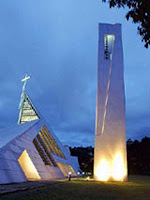 "The drama, however, was a little off, or so I thought when I first saw the church in late 2002. The composition seemed to lack something and (I later found out) it was the carillon that had to wait until now to be built. Additional funds were raised (by High School Class ’60 and College ’64) in the interim and happily, the carillon, also designed by Recio+Casas, was finally built last year and inaugurated in October."The tall white bell tower is separate from the main structure and balances its geometry carefully. It houses 18 bells and an Angelus bell that now gives students and passersby notice of events, masses and hours of prayer. The 18 bells are named, following an old liturgical tradition, after the Blessed Trinity, saints and the blessed. Jesus, Mary, Joseph and the Holy Saints above! This carillon rocks!"
"The drama, however, was a little off, or so I thought when I first saw the church in late 2002. The composition seemed to lack something and (I later found out) it was the carillon that had to wait until now to be built. Additional funds were raised (by High School Class ’60 and College ’64) in the interim and happily, the carillon, also designed by Recio+Casas, was finally built last year and inaugurated in October."The tall white bell tower is separate from the main structure and balances its geometry carefully. It houses 18 bells and an Angelus bell that now gives students and passersby notice of events, masses and hours of prayer. The 18 bells are named, following an old liturgical tradition, after the Blessed Trinity, saints and the blessed. Jesus, Mary, Joseph and the Holy Saints above! This carillon rocks!" We had a lunch program in nearby Cervini Hall. While eating, it was announced that the Ateneo Football Team was up against UP at the football fields accross the Blue Eagle Gym. I managed the high school soccer team during my senior year so I decided to drop by to see if some old friends were there. I was right! Like die-hard football fanatics, they were still watching even after graduating. Coach Ompong Merida was very concentrated on the game in the players' box so I didn't get to greet him.
We had a lunch program in nearby Cervini Hall. While eating, it was announced that the Ateneo Football Team was up against UP at the football fields accross the Blue Eagle Gym. I managed the high school soccer team during my senior year so I decided to drop by to see if some old friends were there. I was right! Like die-hard football fanatics, they were still watching even after graduating. Coach Ompong Merida was very concentrated on the game in the players' box so I didn't get to greet him.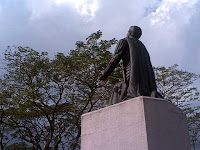 I always had a difficult time watching Ateneo-UP games. I ended up singing two alma mater songs after every game. Hehe! It was funny since I knew the cheers on both sides as the drums blasted their way to inspire the players to fight harder.As I looked around, there were more childhood memories. Just across the fields was the statue of Saint Ignatius, another campus landmark. It was occasionaly the talk of town, especially when the sword disappeared, no thanks to some prankster. Right beside it was a field I used to play in after class during my grade school days since it was right beside the grade school parking area.
I always had a difficult time watching Ateneo-UP games. I ended up singing two alma mater songs after every game. Hehe! It was funny since I knew the cheers on both sides as the drums blasted their way to inspire the players to fight harder.As I looked around, there were more childhood memories. Just across the fields was the statue of Saint Ignatius, another campus landmark. It was occasionaly the talk of town, especially when the sword disappeared, no thanks to some prankster. Right beside it was a field I used to play in after class during my grade school days since it was right beside the grade school parking area. The field formed part of the Manila Observatory Complex which we would wander into after catching grasshoppers, bugs and other insects. I remember distinctly that we would knock on the doors of the observatory and ask the caretaker politely if they would allow us in to look at the exhibits. If we were extra nice, they would allow us to view the telescope to check out the sun. So did my childhood fascination for astronomy begin with those visits to the observatory.Those were the days!
The field formed part of the Manila Observatory Complex which we would wander into after catching grasshoppers, bugs and other insects. I remember distinctly that we would knock on the doors of the observatory and ask the caretaker politely if they would allow us in to look at the exhibits. If we were extra nice, they would allow us to view the telescope to check out the sun. So did my childhood fascination for astronomy begin with those visits to the observatory.Those were the days!
Photo credits: The smaller photos of the Gesu came from the Ateneo and EAPI websites and Paolo Alcazaren.
I had been planning to go to Lukang for the longest time after finding out that this heritage town was very near Taichung. But for some reason or another, we always had something to do. It was our last day so it was now or never. After our group heard Mass (it was like we were in the Philippines since the priest and churchgoers were all Filipinos) and had lunch at this Filipino restaurant in front, there were proposals to do some last-minute shopping. Since I had no intention of doing that, I made my move and asked permission to make my own plans. So as soon as it was given a go, I took a cab to the Taichung Train Station, which itself was an important heritage structure. It's sad that we no longer have our grand old train stations in the Philippines. Tutuban Station, our central train station at the time it was still in use, although the facade had been preserved, the interiors and the surrounding environment had been altered beyond recognition.Some quarters say it should have been preserved as a train station since in most parts of the world, even in countries close to home, they still have their grand old train stations to be proud of. Other noteworthy stations in the Philippines include the Paco Train Station which is close to 100 percent demolished again under Mayor Atienza's watch, to be converted as always, into another shopping mall; and the major provincial stations in the cities of Malolos, San Fernando, Tarlac and Dagupan which, if Northrail does things right, will be restored and integrated into the newer terminals they will be building.
So as soon as it was given a go, I took a cab to the Taichung Train Station, which itself was an important heritage structure. It's sad that we no longer have our grand old train stations in the Philippines. Tutuban Station, our central train station at the time it was still in use, although the facade had been preserved, the interiors and the surrounding environment had been altered beyond recognition.Some quarters say it should have been preserved as a train station since in most parts of the world, even in countries close to home, they still have their grand old train stations to be proud of. Other noteworthy stations in the Philippines include the Paco Train Station which is close to 100 percent demolished again under Mayor Atienza's watch, to be converted as always, into another shopping mall; and the major provincial stations in the cities of Malolos, San Fernando, Tarlac and Dagupan which, if Northrail does things right, will be restored and integrated into the newer terminals they will be building. Talk about communication gap since no one in the station knew how to speak English and purchasing a ticket was close to impossible! It was a good thing one of the staff was helpful enough and asked among passengers entering the station who understood English. We finally found a kind soul to whom I explained that I wanted to purchase a ticket to Changhua since there was no direct train to Lukang. When the station staff finally understood, he even accompanied me to the ticket booth and pointed me to the train which I had to board.I read in Wikipedia that the train did not pass by Lukang because of "the city's refusal to allow railroads to pass through the city led to losses in trade in commerce, which, in turn led to Lukang's decline. This same decline, however, averted the modernization processes that demolished historical buildings in Tainan and Taipei, leaving Lukang preserved as it was in its heyday."
Talk about communication gap since no one in the station knew how to speak English and purchasing a ticket was close to impossible! It was a good thing one of the staff was helpful enough and asked among passengers entering the station who understood English. We finally found a kind soul to whom I explained that I wanted to purchase a ticket to Changhua since there was no direct train to Lukang. When the station staff finally understood, he even accompanied me to the ticket booth and pointed me to the train which I had to board.I read in Wikipedia that the train did not pass by Lukang because of "the city's refusal to allow railroads to pass through the city led to losses in trade in commerce, which, in turn led to Lukang's decline. This same decline, however, averted the modernization processes that demolished historical buildings in Tainan and Taipei, leaving Lukang preserved as it was in its heyday." The train trip was less than an hour. In Changhua City, I proceeded to the bus station conveniently located in front of the train station. I boarded a bus to Lukang which was 45 minutes away. I don't remember how much I spent since in both rides, they got the tickets from me (I usually keep the tickets in my albums). But I know it was very affordable.Taiwan's three largest cities today are Taipei, Kaohsiung and Taichung. But in the 19th century, it was Tainan (the former capital), Lukang and Bangka (now a district of Taipei). During the Qing Dynasty, Lukang was an major trading port owing to its close proximity to Fujian Province as well as the depth of its harbour. The subsequent silting of the harbour and bypass of the railway system led to the city's decline, but as a result, left behind a well-preserved heritage town.
The train trip was less than an hour. In Changhua City, I proceeded to the bus station conveniently located in front of the train station. I boarded a bus to Lukang which was 45 minutes away. I don't remember how much I spent since in both rides, they got the tickets from me (I usually keep the tickets in my albums). But I know it was very affordable.Taiwan's three largest cities today are Taipei, Kaohsiung and Taichung. But in the 19th century, it was Tainan (the former capital), Lukang and Bangka (now a district of Taipei). During the Qing Dynasty, Lukang was an major trading port owing to its close proximity to Fujian Province as well as the depth of its harbour. The subsequent silting of the harbour and bypass of the railway system led to the city's decline, but as a result, left behind a well-preserved heritage town. Anyway, I arrived in Lukang at about 3 p.m. which gave me about two hours to walk around before I went back to Taichung. My first stop was the Wenkai Academy, Civil Shrine and Martial Temple. Wenkai Academy nurtured many of Lukang's cultural elite before the establishment of a school system. The Civil Shrine served as home to Lukang's first literary group. In fact, two of its walls contain works of prominent calligraphers.The Martial Temple's main deity is Kuan Kung, the God of War. He is a symbol of uprightness and bravery, but was also good at accounting and the management of finances. This is why his followers among business people worship him as the God of Commerce too.
Anyway, I arrived in Lukang at about 3 p.m. which gave me about two hours to walk around before I went back to Taichung. My first stop was the Wenkai Academy, Civil Shrine and Martial Temple. Wenkai Academy nurtured many of Lukang's cultural elite before the establishment of a school system. The Civil Shrine served as home to Lukang's first literary group. In fact, two of its walls contain works of prominent calligraphers.The Martial Temple's main deity is Kuan Kung, the God of War. He is a symbol of uprightness and bravery, but was also good at accounting and the management of finances. This is why his followers among business people worship him as the God of Commerce too. My next stop was Lungshan Temple, said to be the best-preserved and most beautiful Ching Dynasty building in Taiwan. Transferred to its present site in 1786, it is the foremost of all Taiwan temples because of its excellent construction and exquisite carvings.I stopped by many more sites along the way. One peculiar structure was called the half-side well. During the olden days, it was only the wealthy who could afford to own wells. But the kind-hearted owner of this well, placed half of it outside the walls of his home so that the less-fortunate could partake of his water supply. Although no longer in use, the well reminds us of the magnanimous spirit of Lukang and its people.
My next stop was Lungshan Temple, said to be the best-preserved and most beautiful Ching Dynasty building in Taiwan. Transferred to its present site in 1786, it is the foremost of all Taiwan temples because of its excellent construction and exquisite carvings.I stopped by many more sites along the way. One peculiar structure was called the half-side well. During the olden days, it was only the wealthy who could afford to own wells. But the kind-hearted owner of this well, placed half of it outside the walls of his home so that the less-fortunate could partake of his water supply. Although no longer in use, the well reminds us of the magnanimous spirit of Lukang and its people. At the end of the road, actually its the first stop if you followed the prescribed walking tour, is Tienhou Temple, dedicated to Matsu, Goddess of the Sea, who was believed to have protected early immigrants to Taiwan. The temple was buzzing with so much activity since there was some sort of festival. I was in fact, treated to the acrobatic antics of a lion dance troupe when I arrived. The performance was very entertaining!Anyway, it was about to get dark and I had to rush back to Taichung for the festival. At the bus station, while I was trying to find the right bus back to Changhua, I chanced upon a group speaking in Filipino. So I approached them and asked which was the most convenient way to get to Taichung. They pointed me to a coaster which went direct to the city. Perfect! So I was back in time for our booth duty and to pack my stuff for our departure the next day. Hehe!
At the end of the road, actually its the first stop if you followed the prescribed walking tour, is Tienhou Temple, dedicated to Matsu, Goddess of the Sea, who was believed to have protected early immigrants to Taiwan. The temple was buzzing with so much activity since there was some sort of festival. I was in fact, treated to the acrobatic antics of a lion dance troupe when I arrived. The performance was very entertaining!Anyway, it was about to get dark and I had to rush back to Taichung for the festival. At the bus station, while I was trying to find the right bus back to Changhua, I chanced upon a group speaking in Filipino. So I approached them and asked which was the most convenient way to get to Taichung. They pointed me to a coaster which went direct to the city. Perfect! So I was back in time for our booth duty and to pack my stuff for our departure the next day. Hehe!
 We made a day trip to Taipei the day after that tiring journey to Nantou. Our first stop was the main office of MECO where me made a courtesy call to Gen. Edgardo Espinosa, resident representative of MECO Taiwan. We then proceeded to the Ministry of Transportation and Communications for a courtesy call to Mr. C. T. Su, Director General of the Tourism Bureau. With all those appointments, our entire morning was gone.So after lunch, we went straight to the National Palace Museum. It is said to house one of the best collections of Chinese artifacts. In fact, the collection is quite controversial and is the subject of a dispute between the Mainland and Taiwan.
We made a day trip to Taipei the day after that tiring journey to Nantou. Our first stop was the main office of MECO where me made a courtesy call to Gen. Edgardo Espinosa, resident representative of MECO Taiwan. We then proceeded to the Ministry of Transportation and Communications for a courtesy call to Mr. C. T. Su, Director General of the Tourism Bureau. With all those appointments, our entire morning was gone.So after lunch, we went straight to the National Palace Museum. It is said to house one of the best collections of Chinese artifacts. In fact, the collection is quite controversial and is the subject of a dispute between the Mainland and Taiwan. The National Palace Museum was established in Beijing in 1925 with the expulsion of the last emperor Puyi. In the 1930s and 1940s, the artifacts, which consisted of the valuables of the former Imperial family, were moved from place to place to avoid falling into the hands of the invading Japanese.
The National Palace Museum was established in Beijing in 1925 with the expulsion of the last emperor Puyi. In the 1930s and 1940s, the artifacts, which consisted of the valuables of the former Imperial family, were moved from place to place to avoid falling into the hands of the invading Japanese. During the final years of the Chinese Civil War, Chang Kai-shek ordered the transfer of the museum collections from Beijing to Taiwan. This transfer remains controversial with Mainland China who considered it looting. While the Taiwanese argue that if the artifacts were not transfered, many would have been destroyed during the Cultural Revolution.The existence of the collection in Taiwan is also a cause for controversy among independence supporters who see it as a symbol of association with the Mainland. But despite all those controversies, it is an impressive collection. There was an extensive renovation on-going when we visited. But the museum was finally reopened in December 2006 after four years of renovation.
During the final years of the Chinese Civil War, Chang Kai-shek ordered the transfer of the museum collections from Beijing to Taiwan. This transfer remains controversial with Mainland China who considered it looting. While the Taiwanese argue that if the artifacts were not transfered, many would have been destroyed during the Cultural Revolution.The existence of the collection in Taiwan is also a cause for controversy among independence supporters who see it as a symbol of association with the Mainland. But despite all those controversies, it is an impressive collection. There was an extensive renovation on-going when we visited. But the museum was finally reopened in December 2006 after four years of renovation. After the museum, we proceeded to Chiang Kai-shek Memorial Hall. I would consider this the most defining landmark of Taiwan and thus a must visit for any visitor. Completed in 1980, five years after Chiang Kai-shek's death, the octagonal memorial hall rises 70 meters. It is a white structure with blue glazed glass tiles. A total of 89 steps lead to the entrance representing the age of Chiang Kai-shek when he died. Inside the hall is a large bronze statue of the late general. The hall is found in a 240,000 square meter park which also contains the National Concert Hall and National Theater.
After the museum, we proceeded to Chiang Kai-shek Memorial Hall. I would consider this the most defining landmark of Taiwan and thus a must visit for any visitor. Completed in 1980, five years after Chiang Kai-shek's death, the octagonal memorial hall rises 70 meters. It is a white structure with blue glazed glass tiles. A total of 89 steps lead to the entrance representing the age of Chiang Kai-shek when he died. Inside the hall is a large bronze statue of the late general. The hall is found in a 240,000 square meter park which also contains the National Concert Hall and National Theater.
 At the time we were visiting Taipei, Taipei 101, now considered the tallest building in the world, was near completion. I remember them pointing it to us while we were on the road. I had wanted to visit the Longshan Temple but we didn't have time anymore since we had to rush back to Taichung for the festival. But before going home, we passed by the Huaxi Street Tourist Night Market which was near Longshan Temple, to eat dinner and do a little shopping as well.
At the time we were visiting Taipei, Taipei 101, now considered the tallest building in the world, was near completion. I remember them pointing it to us while we were on the road. I had wanted to visit the Longshan Temple but we didn't have time anymore since we had to rush back to Taichung for the festival. But before going home, we passed by the Huaxi Street Tourist Night Market which was near Longshan Temple, to eat dinner and do a little shopping as well. Huaxi is also known as "Snake Alley" and is famous for the many small restaurants which serves about anything that walks, crawls or swims. There were of course a lot of snakes. They were used in various ways such as snake soup, snake blood or bile wine, and snake meat. Snake is believed to be one of the best aphrodisiacs according to the Chinese.
Huaxi is also known as "Snake Alley" and is famous for the many small restaurants which serves about anything that walks, crawls or swims. There were of course a lot of snakes. They were used in various ways such as snake soup, snake blood or bile wine, and snake meat. Snake is believed to be one of the best aphrodisiacs according to the Chinese.
But the one thing I could not take was seeing the turtle meat! Looking at turtle meat in one pile, without their shells, made me want to puke! Remembering what I saw made me think of where these restaurants actually get their supplies. It's economically-challenged but naturally rich and diverse countries like ours which lose our wildlife to the dinner tables and traditional apothecaries of East Asia. In fact, the latest brouhaha in Tubattaha had to do with a boat filled with stuffed turtles!
I obviously did not want to eat anything exotic after seeing the turtles. I couldn't remember what it was but it was definitely beef, chicken or pork with vegetables. If only we had more time to go around. But the group had to rush back to Taichung to attend to the giant lantern.
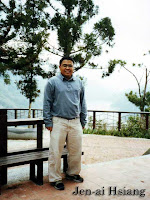 Since we had been in Taichung the whole time and usually did nothing during the day, our Taiwanese guide Frank, who worked with the MECO office in Taichung, arranged for a van to take us to this place he called "snowy mountain." We didn't know where exactly we were going since all the names were in Mandarin. But since we were yearning to go around, we said yes. The trip took several hours along the Central Cross-Island Highway or Route 8. I also distinctly remember that we wasted so much time because of a flat tire!
Since we had been in Taichung the whole time and usually did nothing during the day, our Taiwanese guide Frank, who worked with the MECO office in Taichung, arranged for a van to take us to this place he called "snowy mountain." We didn't know where exactly we were going since all the names were in Mandarin. But since we were yearning to go around, we said yes. The trip took several hours along the Central Cross-Island Highway or Route 8. I also distinctly remember that we wasted so much time because of a flat tire! On the way, our group paid a courtesy call to Mr. Yukan Nafu, chief of Jen-ai Hsiang (Ren-ai Township) in Nantou County. The place reminded me so much of our laidback mountain towns in the Cordilleras. The mountain climate was very pleasing to the senses. It's sad Baguio City air is no longer as clean as it used to be and you really have to go into the rural areas to enjoy nature at its finest.
On the way, our group paid a courtesy call to Mr. Yukan Nafu, chief of Jen-ai Hsiang (Ren-ai Township) in Nantou County. The place reminded me so much of our laidback mountain towns in the Cordilleras. The mountain climate was very pleasing to the senses. It's sad Baguio City air is no longer as clean as it used to be and you really have to go into the rural areas to enjoy nature at its finest.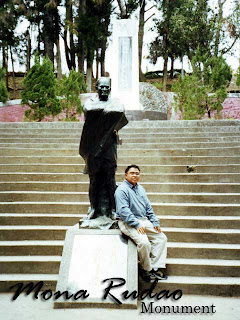 Also in Ren-ai, we dropped by the Mona Rudao Monument, which was erected to honor Mona Rudao, a chief of the Atayal Tribe, who led his tribe people in the Wushe Anti-Japanese Incident.Anyway, it turns out, we were on our way to the highest point on the Taiwan Highway System. Although I know it was somewhere inside the Taroko National Park, it was only after research that I found out that this area was known as Wuling. We took photos in the marker in Hehuanshan Pass, which at 3275 meters above see level is the highest road pass in East Asia.
Also in Ren-ai, we dropped by the Mona Rudao Monument, which was erected to honor Mona Rudao, a chief of the Atayal Tribe, who led his tribe people in the Wushe Anti-Japanese Incident.Anyway, it turns out, we were on our way to the highest point on the Taiwan Highway System. Although I know it was somewhere inside the Taroko National Park, it was only after research that I found out that this area was known as Wuling. We took photos in the marker in Hehuanshan Pass, which at 3275 meters above see level is the highest road pass in East Asia.
 The fog was so thick, it was difficult to see things around. So obviously, the view of the mountains was blocked as well. In fact, it was so cold, it was actually snowing. Near the marker were several makeshift stalls which sold hot meals such as noodles and grilled sausages. It was good someone posted his photos of Wuling so I was able to see the view of the mountains sans the thick fog.
The fog was so thick, it was difficult to see things around. So obviously, the view of the mountains was blocked as well. In fact, it was so cold, it was actually snowing. Near the marker were several makeshift stalls which sold hot meals such as noodles and grilled sausages. It was good someone posted his photos of Wuling so I was able to see the view of the mountains sans the thick fog.
 We didn't stay too long up there since it was freezing cold and there was nothing to see at that time. Winter is not a good time to go up. So the group made its way down the mountain again.
We didn't stay too long up there since it was freezing cold and there was nothing to see at that time. Winter is not a good time to go up. So the group made its way down the mountain again.
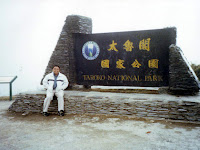 Maybe if I get the chance, I should come back here during the summer months. The brochure of Taroko National Park has very enticing photos of the many natural attractions of the park. We decided to rest early that night since we were going to Taipei the next day.
Maybe if I get the chance, I should come back here during the summer months. The brochure of Taroko National Park has very enticing photos of the many natural attractions of the park. We decided to rest early that night since we were going to Taipei the next day.
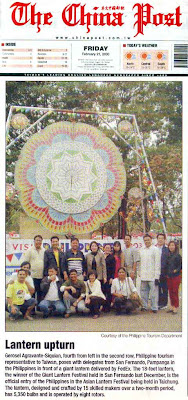 How can one forget the date we left for Taiwan. It was February 14, 2003. The City Government of San Fernando was being sent by the Department of Tourism to represent the country in the 2003 Taiwan Lantern Festival which was held in Taichung. I had previously been to Taiwan when I was five but we only went around Taipei. So this was my first time to get out of the capital city. But time was limited since although we were there for almost two weeks, most of our time was at the festival and meeting with local officials.It was a late night Philippine Airlines flight since I remember, our passports were stamped in Taipei on the 15th. We were met by the Tourism Attache who accompanied us on the two-hour bus to Taichung, Taiwan's culture city. The bus ride was very comfortable since the chairs were really big. It was like sleeping in your own living room. When we arrived in Taichung we all went straight to bed.Most of our time that day was spent at the Taichung branch of the Manila Economic and Cultural Office (MECO), our de facto embassy in Taiwan. That night was the opening of the festival. We had passes but didn't get to use them since we were busy preparing the San Fernando giant lantern.
How can one forget the date we left for Taiwan. It was February 14, 2003. The City Government of San Fernando was being sent by the Department of Tourism to represent the country in the 2003 Taiwan Lantern Festival which was held in Taichung. I had previously been to Taiwan when I was five but we only went around Taipei. So this was my first time to get out of the capital city. But time was limited since although we were there for almost two weeks, most of our time was at the festival and meeting with local officials.It was a late night Philippine Airlines flight since I remember, our passports were stamped in Taipei on the 15th. We were met by the Tourism Attache who accompanied us on the two-hour bus to Taichung, Taiwan's culture city. The bus ride was very comfortable since the chairs were really big. It was like sleeping in your own living room. When we arrived in Taichung we all went straight to bed.Most of our time that day was spent at the Taichung branch of the Manila Economic and Cultural Office (MECO), our de facto embassy in Taiwan. That night was the opening of the festival. We had passes but didn't get to use them since we were busy preparing the San Fernando giant lantern.
 Anyway, when our work was done, I checked if I could still catch the program. But when I got close to the stage, President Chen Shui-bian was about to leave. I was just about a meter or two away but because of tight security, I wasn't able to have a photo taken with him like I usually do when I get the chance to meet heads of state . Who wouldn't? Oh well!
Anyway, when our work was done, I checked if I could still catch the program. But when I got close to the stage, President Chen Shui-bian was about to leave. I was just about a meter or two away but because of tight security, I wasn't able to have a photo taken with him like I usually do when I get the chance to meet heads of state . Who wouldn't? Oh well!
On the right is the main lantern that was lit by President Chen. I remember that the NT$10 million (US$287,356) spent by Chunghua Telecom to produce this 20-meter lantern was the talk of the town during the festival.
 We only got to go around Taichung on the 17th and 18th. I remember walking around Taichung Park, also known as Zhong Shan Park. Its main attraction is Jih-Yueh Lake which was originally a natural pond. After years of human modifications, it now covers an area of about 13,500 square meters. In the middle of the lake is a pavillion built in 1908 to commemorate the completion of the north-south railway when the island was still under Japanese occupation. This pavilion has become an important symbol of the city.
We only got to go around Taichung on the 17th and 18th. I remember walking around Taichung Park, also known as Zhong Shan Park. Its main attraction is Jih-Yueh Lake which was originally a natural pond. After years of human modifications, it now covers an area of about 13,500 square meters. In the middle of the lake is a pavillion built in 1908 to commemorate the completion of the north-south railway when the island was still under Japanese occupation. This pavilion has become an important symbol of the city.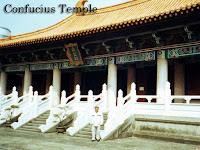 It was while reading on the Japanese rule in Taiwan that I found out that the Republica Filipina was not the first Asian republic as some would claim, but was predated by the Republic of Formosa (May 24, 1895) and the Republic of Ezo in Japan (December 25, 1868) among others. In fact, according to Wikipedia, the first republics in Asia are Vaishali, Licchavi and Vajji all established in India circa 600 B.C.
It was while reading on the Japanese rule in Taiwan that I found out that the Republica Filipina was not the first Asian republic as some would claim, but was predated by the Republic of Formosa (May 24, 1895) and the Republic of Ezo in Japan (December 25, 1868) among others. In fact, according to Wikipedia, the first republics in Asia are Vaishali, Licchavi and Vajji all established in India circa 600 B.C. The next day, we visited the Confucius Temple. According to the Taichung website "Taichung's peaceful Confucius Temple features impressive, rectangular Sung Dynasty-style structures, surrounded by spacious courtyards and a garden. The buildings and grounds are usually quiet and near-deserted, giving the temple a relaxing, meditative air. Once a year, during Confucius' birthday (Teachers' Day), the temple comes to life for a dawn ceremony featuring processions of marchers and musicians clad in traditional Chinese imperial court costumes, government officials and hundreds of spectators." Beside it is the Martyrs Shrine. But we weren't able to go inside since it's closed on weekdays.
The next day, we visited the Confucius Temple. According to the Taichung website "Taichung's peaceful Confucius Temple features impressive, rectangular Sung Dynasty-style structures, surrounded by spacious courtyards and a garden. The buildings and grounds are usually quiet and near-deserted, giving the temple a relaxing, meditative air. Once a year, during Confucius' birthday (Teachers' Day), the temple comes to life for a dawn ceremony featuring processions of marchers and musicians clad in traditional Chinese imperial court costumes, government officials and hundreds of spectators." Beside it is the Martyrs Shrine. But we weren't able to go inside since it's closed on weekdays.
 We also got to visit the Paochueh Temple, a Buddhist temple in the northern edge of the city which is known for its big Buddha statue. The 88-foot gold statue is a big-bellied, happy Buddha known as Maitreya. Below it is an inscription which translates "Happiness to All."
We also got to visit the Paochueh Temple, a Buddhist temple in the northern edge of the city which is known for its big Buddha statue. The 88-foot gold statue is a big-bellied, happy Buddha known as Maitreya. Below it is an inscription which translates "Happiness to All."
The temple complex is a quiet and secluded place where one can reflect and meditate. The main shrine hall, with a striking blue glazed roof, was built in 1928 and houses three Buddha images protected by a row of fierce guardians.
 That afternoon, we also made a courtesy call to Mr. Chen Tien-Wen, the Vice Speaker of the Taichung City Council at the historic Taichung City Hall. It was commissioned in 1912 as the Taichung State Building by the Japanese colonial government. This wood and re-inforced brick structure was completed in 1924 and is considered one of the most elaborate and ornate buildings of the Japanese colonial period in Taiwan.
That afternoon, we also made a courtesy call to Mr. Chen Tien-Wen, the Vice Speaker of the Taichung City Council at the historic Taichung City Hall. It was commissioned in 1912 as the Taichung State Building by the Japanese colonial government. This wood and re-inforced brick structure was completed in 1924 and is considered one of the most elaborate and ornate buildings of the Japanese colonial period in Taiwan.
That's it for Taichung. Up next is the day trip to the mountains in Nantou County we did the day after.
Heritage watch
■ Chinese boat loaded with stuffed sea turtles released
■ Legal eagles to help prosecute Tubbataha reef poachers
■ Legal team formed to help prosecute Chinese poachers
■ Chinese envoy’s letter led to suspected poachers’ release
■ Chinese gov’t pressed RP to free Tubbataha poachers
This is a very sad issue for the Philippines. It just shows how weak our government is in protecting our natural heritage. It also shows how other nations condone the illegal acts of their citizens.
■ Lost but not forgotten lighthouse
■ Pila townsfolk preserve heritage town
Here is some good news for everyone. I hope other localities follow Pila's example.
■ Historic church, houses fill Laguna town’s coffers
■ Restoring Dagupan’s most treasured heritage
 Yesterday, I attended a Mass for Ateneo jubilarian classes at the Church of the Gesu in Ateneo. My high school batch is celebrating its tenth anniversary this year. The Mass really brought back memories since all of a sudden, I was an impromptu lector and altar server. Hehe!
Yesterday, I attended a Mass for Ateneo jubilarian classes at the Church of the Gesu in Ateneo. My high school batch is celebrating its tenth anniversary this year. The Mass really brought back memories since all of a sudden, I was an impromptu lector and altar server. Hehe! The Church of the Gesu was built several years after I left the Ateneo and transferred to neighboring UP. It was a low hill during my twelve years stay at the Loyola Heights campus. Although we already knew that the University Church, one that would replace the grand San Ignacio Church in Intramuros as the landmark church and religious center of the Ateneo de Manila, would be built on that hill. According to the Ateneo website, it was in 1949 that "Fr. William Masterson, S.J. dreamed of a chapel on the highest point of Ateneo’s new campus in Loyola Heights, which was to be the icon of everything the Ateneo stands for as a Catholic, Filipino and Jesuit institution." More than 50 years later, that dream became a reality and the finished product is nothing but impressive!
The Church of the Gesu was built several years after I left the Ateneo and transferred to neighboring UP. It was a low hill during my twelve years stay at the Loyola Heights campus. Although we already knew that the University Church, one that would replace the grand San Ignacio Church in Intramuros as the landmark church and religious center of the Ateneo de Manila, would be built on that hill. According to the Ateneo website, it was in 1949 that "Fr. William Masterson, S.J. dreamed of a chapel on the highest point of Ateneo’s new campus in Loyola Heights, which was to be the icon of everything the Ateneo stands for as a Catholic, Filipino and Jesuit institution." More than 50 years later, that dream became a reality and the finished product is nothing but impressive! Archt. Paolo Alcazaren gives us more information on the impressive design of the Gesu in his Philippine Star column: "The church is a modernist take on a long line of Jesuit churches that have their origins in the original Gesu in Rome. The Ateneo has had several of these churches starting with the one destroyed in Intramuros. The campus in Loyola, to which the school moved after the Second World War, was also a modern remake of a formerly urban campus with wide, open and green spaces (undefiled by telephone and power cables, which the original planners – thank God – buried underneath).
Archt. Paolo Alcazaren gives us more information on the impressive design of the Gesu in his Philippine Star column: "The church is a modernist take on a long line of Jesuit churches that have their origins in the original Gesu in Rome. The Ateneo has had several of these churches starting with the one destroyed in Intramuros. The campus in Loyola, to which the school moved after the Second World War, was also a modern remake of a formerly urban campus with wide, open and green spaces (undefiled by telephone and power cables, which the original planners – thank God – buried underneath). "The Ateneo chose the firm of Recio+Casas to design the new Gesu. Bong Recio, the principal in charge, is an alumnus. He took pains to study the site to find the best geometry and location for the building. The striking design was unlike anything seen since another geometric wonder (the UP dome by Leandro Locsin) was constructed 50 years earlier. The angle-roofed structure is an abstraction of a bird in flight (an eagle, of course) and is perched on a slight knoll with a large "sunken" quad in front of it – perfect siting for prominence despite the structure’s relatively small size.
"The Ateneo chose the firm of Recio+Casas to design the new Gesu. Bong Recio, the principal in charge, is an alumnus. He took pains to study the site to find the best geometry and location for the building. The striking design was unlike anything seen since another geometric wonder (the UP dome by Leandro Locsin) was constructed 50 years earlier. The angle-roofed structure is an abstraction of a bird in flight (an eagle, of course) and is perched on a slight knoll with a large "sunken" quad in front of it – perfect siting for prominence despite the structure’s relatively small size. "The drama, however, was a little off, or so I thought when I first saw the church in late 2002. The composition seemed to lack something and (I later found out) it was the carillon that had to wait until now to be built. Additional funds were raised (by High School Class ’60 and College ’64) in the interim and happily, the carillon, also designed by Recio+Casas, was finally built last year and inaugurated in October.
"The drama, however, was a little off, or so I thought when I first saw the church in late 2002. The composition seemed to lack something and (I later found out) it was the carillon that had to wait until now to be built. Additional funds were raised (by High School Class ’60 and College ’64) in the interim and happily, the carillon, also designed by Recio+Casas, was finally built last year and inaugurated in October. We had a lunch program in nearby Cervini Hall. While eating, it was announced that the Ateneo Football Team was up against UP at the football fields accross the Blue Eagle Gym. I managed the high school soccer team during my senior year so I decided to drop by to see if some old friends were there. I was right! Like die-hard football fanatics, they were still watching even after graduating. Coach Ompong Merida was very concentrated on the game in the players' box so I didn't get to greet him.
We had a lunch program in nearby Cervini Hall. While eating, it was announced that the Ateneo Football Team was up against UP at the football fields accross the Blue Eagle Gym. I managed the high school soccer team during my senior year so I decided to drop by to see if some old friends were there. I was right! Like die-hard football fanatics, they were still watching even after graduating. Coach Ompong Merida was very concentrated on the game in the players' box so I didn't get to greet him. I always had a difficult time watching Ateneo-UP games. I ended up singing two alma mater songs after every game. Hehe! It was funny since I knew the cheers on both sides as the drums blasted their way to inspire the players to fight harder.
I always had a difficult time watching Ateneo-UP games. I ended up singing two alma mater songs after every game. Hehe! It was funny since I knew the cheers on both sides as the drums blasted their way to inspire the players to fight harder. The field formed part of the Manila Observatory Complex which we would wander into after catching grasshoppers, bugs and other insects. I remember distinctly that we would knock on the doors of the observatory and ask the caretaker politely if they would allow us in to look at the exhibits. If we were extra nice, they would allow us to view the telescope to check out the sun. So did my childhood fascination for astronomy begin with those visits to the observatory.
The field formed part of the Manila Observatory Complex which we would wander into after catching grasshoppers, bugs and other insects. I remember distinctly that we would knock on the doors of the observatory and ask the caretaker politely if they would allow us in to look at the exhibits. If we were extra nice, they would allow us to view the telescope to check out the sun. So did my childhood fascination for astronomy begin with those visits to the observatory.
























